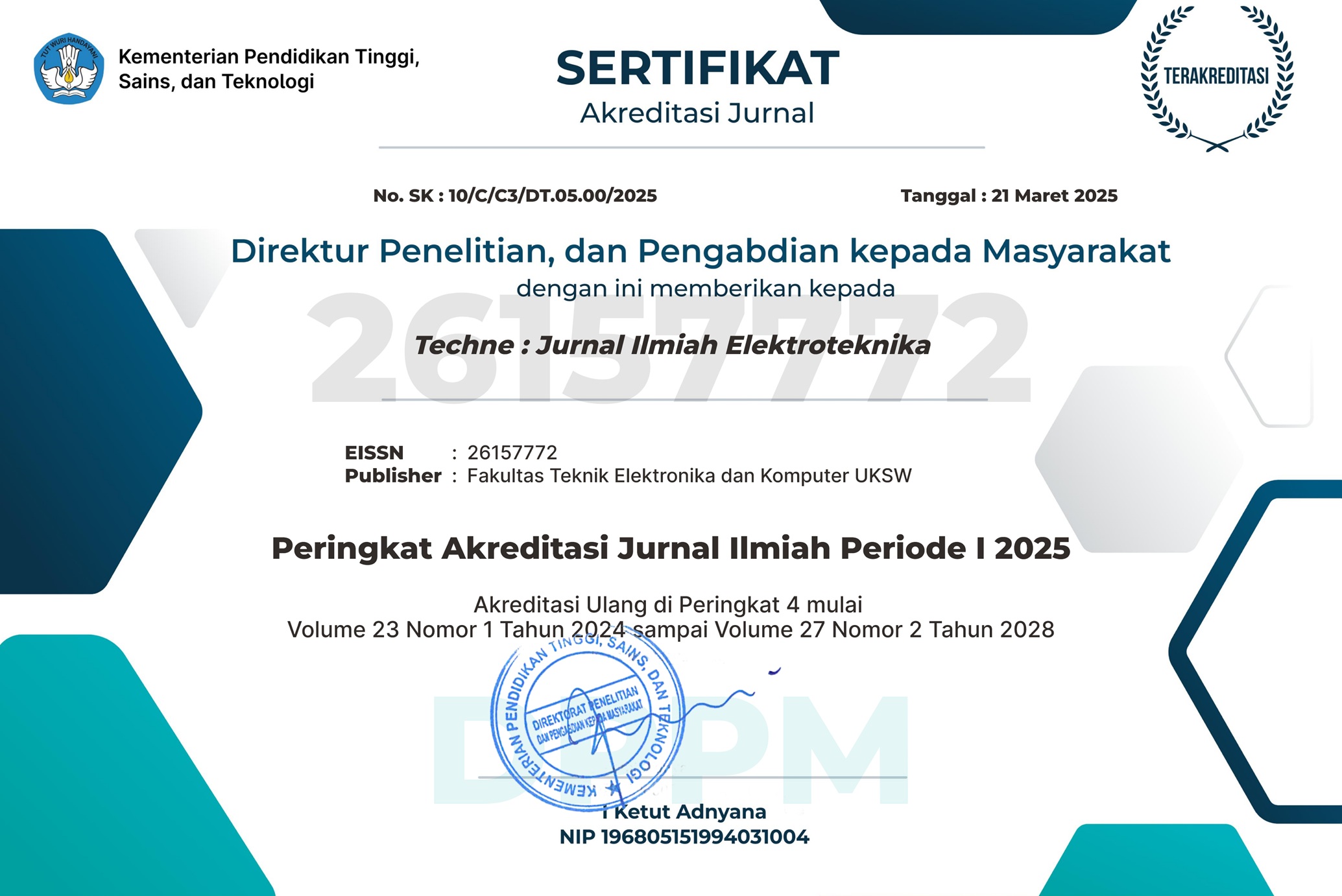Rancang Bangun Maximum Power Point Tracking pada Panel Surya dengan Metode Incremental Conductance Menggunakan Zeta Konverter
DOI:
https://doi.org/10.31358/techne.v22i1.334Keywords:
Incremental Conductance, Maximum Power Point Tracking, Photovoltaic, Zeta ConverterAbstract
Maximum Power Point Tracking (MPPT) is a method of maintaining the maximum output power of solar panels when the power of the solar panel changes over time due to the influence of the load or intensity of sunlight. This research proposed designing MPPT on photovoltaic using the Incremental Conductance method. The incremental Conductance method controls the duty cycle when the voltage and current change values ?I/?V>-I/V. This system uses one solar panel with a power capacity of 100 Wp, a ZETA converter as a DC-DC converter to lower the voltage, and used a load 12V/5W DC lamp. From the tests that have been carried out, the tracking time for MPPT Incremental Conductance is 4,5 seconds with a maximum power of 63,9015 Watt with irradiation of sunlight 813 W/m2. The average power without MPPT is 51,215 Watt, and by using MPPT Incremental Conductance, the average power is 57,274 Watt. So, there is an increase in power when using the MPPT Incremental Conductance control.
Downloads
References
R. Hasrul et al., “Analisis Efisiensi Panel Surya Sebagai Energi Alternatif,” vol. 5, no. 9, pp. 79–87, 2021.
I. Riyanto, Suparmoko, A. Octaviano, and B. Santoso, “A portable photovoltaic powerplant for emergency electrical power supply in disaster affected areas,” Int. J. Simul. Syst. Sci. Technol., vol. 19, no. 1, pp. 9.1-9.5, 2018, doi: 10.5013/IJSSST.a.19.01.09.
H. Widyantoro, S. Sulaiman, R. S. Wahjudi, and R. H. Subrata, “Perancangan Stabilisasi Daya Pada Solar Cell Menggunakan Metode Maximum Power Point Tracking (MPPT),” Semin. Nas. Cendekiawan, vol. 1, no. 5, pp. 1–6, 2019.
A. Fauzi, A. Hiendro, and Yaifurrahman, “Rancang Bangun Battery Control Unit Panel Surya Terhadap Efek Bayangan,” no. 1, p. 7, 2019.
P. Widyantoro, “MPPT System Using Incremental Conductance for Solar Cell in Normal and Partial Shading Conditions,” pp. 352–357, 2019.
H. T. Nurhayati, “Optimasi MPPT ( Maximum Power Point Tracker ) Pada Sistem Photovoltaic menggunakan Algoritma Incremental Conductance.”
A. Rizqi and E. Wahjono, “Implementasi Maximum Power Point Tracking Berbasis Fuzzy Logic Controller Dengan Zeta Converter,” no. April, pp. 36–44, 2021.
S. Pranoto, N. N. Rusli, I. A. T. Distribusi, and I. Pendahuluan, “Penyeimbangan Beban pada Trafo Distribusi Penyulang Akkarena di Unit Layanan Pelanggan Mattoanging PT PLN ( Persero ),” Pros. Semin. Nas. Tek. Elektro dan Inform., vol. 2, no. 1, pp. 37–46, 2020.
A. Kumar, M. Lal Azad, and R. Kumar Chandi, “Modelling of PV Arrays-An effective approach,” Int. J. Appl. Eng. Res., vol. 14, no. 12, pp. 2850–2854, 2019, [Online]. Available: http://www.ripublication.com.
H. Rusiana Iskandar, Y. Bakti Zainal, and A. Purwadi, “Studi Karakteristik Kurva I-V dan P-V pada Sistem PLTS Terhubung Jaringan PLN Satu Fasa 220 VAC 50 HZ menggunakan Tracking DC Logger dan Low Cost Monitoring System,” pp. 174–183, 2017, doi: 10.21063/pimimd4.2017.174-183.
A. . Rois, N. Gunawan, and B. Chayun, “Analisa Performansi dan Monitoring Solar Photovoltaic System ( SPS ) Pada Pembangkit Listrik Tenaga Surya Di Tuban Jawa Timur,” Tek. Pomits, pp. 1–8, 2016.
Z. M. S. Elbarbary and M. A. Alranini, “Review of maximum power point tracking algorithms of PV system,” Front. Eng. Built Environ., vol. 1, no. 1, pp. 68–80, 2021, doi: 10.1108/febe-03-2021-0019.
Prachi Makhija, “Performance Analysis of Solar MPPT techniques Under Partial Shading Condition,” Int. J. Eng. Res., vol. V9, no. 08, pp. 408–413, 2020, doi: 10.17577/ijertv9is080180.
M. A. Islam, A. Merabet, R. Beguenane, H. Ibrahim, and H. Ahmed, “Simulation based study of maximum power point tracking and frequency regulation for stand-alone solar photovoltaic systems,” Renew. Energy Power Qual. J., vol. 1, no. 12, pp. 483–487, 2014, doi: 10.24084/repqj12.378.
M. S. Nkambule, A. N. Hasan, and A. Ali, “MPPT under partial shading conditions based on Perturb & Observe and Incremental Conductance MPPT under partial shading conditions based on Perturb & Observe and Incremental Conductance,” no. November, 2019, doi: 10.23919/ELECO47770.2019.8990426.
S. UTAMI, S. SAODAH, and A. PUDIN, “Penggunaan Algoritma Incremental Conductance pada MPPT dengan Buck Converter untuk Pengujian Indoor dan Outdoor,” ELKOMIKA J. Tek. Energi Elektr. Tek. Telekomun. Tek. Elektron., vol. 6, no. 1, p. 97, 2018, doi: 10.26760/elkomika.v6i1.97.
D. N. Prakoso, A. Affandi, M. Arrijal, R. Abdurrahman, and N. A. Windarko, “Perbandingan Metode MPPT Incremental Conductance Incremental Resistance dan Hill Climbing dengan PSIM,” Jetri J. Ilm. Tek. Elektro, vol. 17, no. 2, p. 175, 2020, doi: 10.25105/jetri.v17i2.6076.
Kambli Omkar Vijay and P. Sriramalakshmi, “Comparison between Zeta Converter and Boost Converter using Sliding Mode Controller,” Int. J. Eng. Res., vol. V5, no. 07, pp. 368–373, 2016, doi: 10.17577/ijertv5is070322.
J. Falin, “Designing DC/DC converters based on ZETA topology,” Analog Appl. J. Texas Instruments Inc., vol. 2Q, pp. 16–21, 2010.
Y. M. Kolewora, E. Firmansyah, and S. Suharyanto, “Mppt Berdasarkan Algoritma P&O Dan Ic Pada Interleaved-Flyback 250W,” Telematika, vol. 11, no. 1, p. 18, 2018, doi: 10.35671/telematika.v11i1.603.
Downloads
Published
How to Cite
Issue
Section
License
Copyright (c) 2022 Mahmudatul Ula, Arief Rahmadani

This work is licensed under a Creative Commons Attribution-NonCommercial-ShareAlike 4.0 International License.








